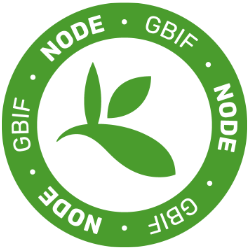Using island biogeography to investigate a weird and scenic landscape in southern Idaho
-- Contributed by Katie Peterson, PhD Student, Parent Lab, Department of Biological Sciences, University of Idaho
I am currently a third year PhD student at the University of Idaho in the Parent Lab. The Parent Lab studies the biodiversity and evolution of organisms that have recently colonized novel, “blank slate”, environments on islands. My research focuses on using the conceptual tool of island biogeography to study island systems comprised of novel habitats, but within a continental context. I am using the theory of island biogeography to understand the current distribution of biodiversity at Craters of the Moon National Monument and Preserve (CRMO) Idaho, USA. I am focusing my collection efforts on the plant community and spiders from Salticidae and Thomisidae, as both plants and spiders are important initial colonizers to novel landscapes.

Standing on the Blue Dragon Lava flow at
Craters of the Moon National Monument and Preserve.
CRMO is a patchwork of island-like units consisting of lava flows and kipukas, which are islands of established vegetation. Each patch varies in age, area, and isolation, which make CRMO a powerful natural laboratory to study island biogeography. The sprawling landscape of CRMO encompasses an area of more than 2,893 square kilometers and is comprised of 60 lava flows and over 500 kipukas. The basaltic lava flows are between 2,000-15,000 years old, which makes CRMO one of the youngest volcanic landscapes in the continental U.S.!
My collections from two initial field seasons at CRMO will contribute to the existing collections at the University of Idaho. Spiders I collect will be added to the William F. Barr Entomological Museum that currently houses more than 1 million specimens. This collection has voucher specimens from original insect surveys conducted at CRMO back in the late 1960s; however, the previous survey did not include spiders, so my collections will significantly increase our knowledge of the current biodiversity of Salticidae (jumping) and Thomisidae (crab) spiders. Digitization efforts in the Barr Museum are already underway to document the Lepidopteran collection of the museum. As sample processing and identification progresses, the spiders I collected will be digitized as well. The plants I collect will also be digitized and they will be added to the Stillinger Herbarium, a collection of more than 200,000 plant specimens. The entire vascular plant collection has been digitized and is publicly accessible through the Consortium of Pacific Northwest Herbaria data portal, which includes collections from a total of 36 herbaria. I am hoping to utilize this data portal as a resource to determine appropriate species pools for future community phylogenetic analyses.


Not a bad view from the field site (left); Collecting spiders using a beating sheet (right).
Museum collections are essential for my research, as voucher specimens that are geo-referenced represent records that can be verified and used as a detailed snapshot of what was present at a specific location at a specific point in time. Species lists can be helpful, but having voucher specimens leads to a higher certainty that the list is accurate. In addition, other scientists can then use the vouchers I create for future analyses. This is exciting because in that way, museum collections can have an everlasting life!
Understanding the possible influences of isolation and area on organisms, even small ones, can be insightful for the entire community. I am thankful to be able to contribute to existing collections by doing fieldwork for my dissertation research so others are able to learn and appreciate the amazing diversity of an interesting landscape via online resources, even if they are unable to see it firsthand!
[Footnote: iDigBio is currently working with the University of Idaho collections to mobilize and share data through the iDigBio portal]







